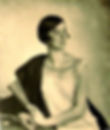(MARY) MILLICENT ABIGAIL ROGERS (1902-1953)

By the time the stunning granddaughter of Standard Oil magnate Henry Huddleston Rogers Sr. elopes with a dashing European aristocrat in 1924, it has become impossible for any offspring of the country’s new caste of corporate tycoons to make a move socially without every paper printing an item about it. On January 10, 1924, readers of The Southampton Press are let in on the secret in an announcement reprinted from The New York Herald. To the delight of the voracious society press, the headstrong daughter of Standard Oil heir Colonel Henry Huddleston Rogers Jr. has secretly married Count Ludwig von Salm-Hoogstraeton in City Hall, informing her parents only after the ceremony. The Herald excitedly describes the Count as a member of an Austrian branch of the ancient German princely house of Salm-Salm and notes that “the bride has held a high place in New York Society since her debut in 1919.” That the Southampton Press would pick up the item from the Herald is hardly surprising. By 1924, Colonel Rogers and his family have been prominent members of the Southampton summer colony for a decade, their comings and goings faithfully recorded in the paper’s “Cottager” columns throughout the year.

At her birth in 1902, Southampton is still in the future for Millicent. As a young child she is spending her time in the sumptuous surroundings of her parents’ New York City townhouse at 26 East 57th Street or at their estate in Tuxedo Park. A childhood beauty, she leads the life of a rich New York Princess of the Gilded Age with winter outings in Central Park and summer visits to the patriarch in Fairhaven, Massachusetts, where there are happy reunions with her many cousins.


Then, in the winter of 1910, a year after this photo was taken, the high-spirited Millicent is stricken with a sore throat, intermittent high fevers and listlessness. Diagnosed with rheumatic fever, a dreaded and often fatal disease at the time, she is bedridden for months. It is time she puts to good use developing her precocious intellect and creative imagination with results that would be hard to exaggerate. Physical exertion is forbidden, slowing her down and giving her the languorous manner that will become a permanent part of her charm. Less welcome, a weak heart will also accompany her through life.
With the full support of her parents, who see that she receives an excellent education at home, Millicent is soon reading and writing well beyond her years and showing a remarkable facility for languages, a gift that her brother Harry, two years her junior, apparently shares. As children, the two use Latin as their secret language whenever they don’t want their parents to know what they’re saying.

Despite her doctor’s warnings that she might not recover, Millicent survives to lead a normal life for a young girl of her class. Like other privileged children, she is often impatient with gloomy governesses, she has lessons in drawing, and she joins the ice-skating rage, which has all ages out on the ice. She takes refuge in books and her own creative imagination whenever life under the strict supervision of two strong-willed parents seems too much for their offspring to bear. Henry Huddleston Rogers Jr., her father, and Mary Page Benjamin were married in 1900 when both were just 20. The presumed heir to his father’s vast fortune, Henry was considered quite a catch, but so was Mary, whose family was also wealthy and highly ranked with cultural credits that added to the family’s social cachet.

Mary is attractive and never lacks admirers in her single years. Among them is Mark Twain, a family friend who is of her parents’ generation but likes to surround himself with young people. Mary is one of the young women chosen by Twain for membership in his all-female Aquarium Club. As their leader, he takes an avuncular role toward his “angelfish,” as he calls them, encouraging their intellectual development with conversation and debate. Mary is a favorite and their long correspondence is eventually collected in a book called “Mark Twain’s Letters to Mary.” As a young married, Mary is a hard-working socialite, albeit one who possesses artistic talent and a well-defined sense of style. Millicent, a freer spirit, sometimes clashes with her talented but socially conventional mother. Yet, their bond holds and remains strong into Mary’s age.

Millicent’s relationship with her father seems more deeply conflicted, especially as her parents’ marital battles increase in frequency and intensity, eventually leading to their divorce in 1929. Millicent is loved but no longer the coddled child made docile by her illness. She begins to display a will of her own that promises to be a match for her father’s. When her grandfather, Henry Sr. dies suddenly in 1909 at age 69, the Colonel is able to step out from under his father’s shadow and become the high-living plutocrat his stunning inheritance permits.

After dividing their time between New York City and Tuxedo Park, the Colonel, his wife Mary and children Millicent and Henry become summer residents in Southampton in 1916 with the completion of their magnificent oceanfront mansion, Black Point, at the intersection of Gin Lane and Old Town Road. For the teenage Millicent, it will mean making new friends among the Meadow Club set, without sacrificing a spot on the A-List for Tuxedo’s famous balls. For the site atop a dune, architects at Walker & Gillette design a Mediterranean-style villa, which Rogers fills with precious antiques, paintings, and eclectic furnishings ranging from the Italian Renaissance to the most modern details. A definite departure from Southampton’s standard sprawling shingled affair, it is commented upon disapprovingly in the press for looking as though it “belonged in Newport.”

Having provided a suitably splendid summer seat for his family, the Colonel will later provide himself with a separate summer headquarters. The Port of Missing Men, as he calls it, will play no great role in his daughter’s life. It is to be a hunting lodge where he can host shooting parties for his hunting buddies--presumably “safe from the ladies,” as one of them put it. On what will eventually encompass 1,200 acres in North Sea, the so-called “hunting box” will be as extravagant in its way as Black Point, reflecting the personal tastes of its owner. The Colonel will spare no expense in its design, bringing in the high-end designer Eleanor McMillan Brown to design the Great Hall, a massive beamed space with a baronial fireplace. It survives into the present, unlike Black Point, which was demolished in the late 1930s.

In late adolescence Millicent keeps a diary, recording the dances, evenings of games and other activities that she seems to enjoy, despite occasional complaints of boredom. She is rich, beautiful and already developing a style of her own--all attributes that are about to make her an irresistible target for constant attention from the press. The few who know her well, know a different Millicent, a quieter, deeper soul who is fun-loving, yes, but eager to put her intellect and her creativity to more serious purpose. Even Southampton begins to feel oppressive. “I’m sick of this place,” she writes in her diary. I want to do something for a change.” With war on the horizon, opportunities arise. She takes a course in home nursing, learning first aid and surgical dressing.

When the U.S. joins the fight and the Colonel is assigned to Washington D.C., Millicent is enrolled in the Madeira School, which proves a bad fit with its fussy emphasis on deportment and neatness. Happily, the war ends in 1919, just as Millicent is ready to make her debut in society and leave the cloistered life of a schoolgirl far behind.

Post-war exuberance is in the air and the 17-year-old Millicent is in great demand at a flurry of dances and dinners in the lead-up to her formal introduction to society. Even before the hoopla of her coming-out, Millicent’s beauty and bold personal style does not go unnoticed in the press—a prelude to the relentless press exposure to come. When she appears at a fantasy ball hosted by her parents at Black Point, costumed as a young queen in a shiny gown with train and headdress, a photographer from Harper’s Bazaar recognizes a rising star and snaps her for the magazine. There are fashion notices in The Washington Post and other newspapers and a full-page photo in Town & Country. In Southampton she is posed romantically among the urns and potted plants at Black Point wearing virginal white and a wide-brimmed flower-trimmed hat—a look that will soon disappear from her wardrobe.

Millicent will be 20 herself in the Roaring Twenties, a time for shedding the old, thrilling to the new—new fashions, new dances, new cocktails served in teacups to flout prohibition. Coming of age at just the right time, Millicent embodies the new freedoms and fashions perfectly and is the center of attention wherever she goes. When she catches the eye of the young Edward, Prince of Wales, who is touring the U.S. in 1919, the attentions of the popular young royal to the bewitching beauty have the press in a frenzy.
Millicent is the Prince’s favorite dance partner in their frequent encounters at social occasions and there is excited talk that Millicent might win the marriage stakes with a wedding not just to a peer of the British realm as so many young American heiresses have managed up to then, but to a future king. Some eyebrows are raised since she has not yet made her debut, but in a time of loosening conventions, few people care.
People are breaking loose and Millicent, with her willowy figure will be the perfect model for the jazz age’s loose-fitting and shocking short chemise dress, which she likes to wear with a Chinese headdress and with her fingernails painted blood red. In the end, the romance with the Prince dims when he returns to England and, as everyone knows, ultimately gives up the crown for the love of another American woman…but that is another story. Millicent is no doubt well aware that the rigid decorum of the English court—not to mention the pastel frocks and frumpy hats—would never have suited her, and that there will no doubt be many more fascinating men in her future.

When it is her turn to make her debut, Millicent is feted in Southampton and Washington but the main event, which the New York Times predicts will “probably be the largest ball of the season,” takes place on November 24 at the Ritz-Carlton in New York. Whole trees are brought into the ballroom, along with all manner of flowers and foliage, and a 30-piece orchestra has instructions to play through the night. Millicent’s dress of plain white satin shaped over a white satin foundation with a minimum of froufrous receives favorable comment in the press, while some reporters find fault with the party, complaining that it was too well attended. According to their reports, 2000 people had received invitations and the 1300 who accepted had crowded the dance floor to the point of gridlock.

Officially recognized as marriageable, Millicent collects proposals and revels in her new freedom. Her long illness and the strict limits society still places on the activities of young girls have tried her patience, but Southampton offers many opportunities to make up for lost time during the summer following her debut. There is no end of parties, no lack of suitors. A romance with the tall, handsome Jimmy Thompson, a fellow Southampton cottager, appears to be more serious than Millicent’s other flirtations and, indeed, the Rogers announce the couple’s engagement before the summer is over. Plans for Millicent to accompany her parents to Europe that winter remain unchanged, however, and James comes to the pier to see her off, never suspecting that their marriage plans will not survive Millicent’s heady introduction to European society.

The Rogers family travels in grand style, of course, crossing the ocean on the White Star ocean liner, the Queen Mary, and staying in the best hotels in Paris, London and beyond. Millicent’s list of admirers swells and in June she breaks her engagement to Jimmy. She is apparently an enthusiastic traveler during several such trips, testing her language facility, finding beauty in the history and cultures of the places she visits, and impressing others with her own beauty, intellect and wit. In Italy, the 18-year-old Millicent makes a conquest of the Duke d’Aosta, a handsome member of Italian royalty who asks her to marry him. But Mussolini disapproves, as does Millicent’s father, spelling an end to the romance.

Millicent goes on to cast her spell on another handsome aristocrat whose reputation for style and dash is a match for her own. A soldier who would fight in two world wars and in the Russian Civil War before fleeing his country, Serge Obolensky was born a prince in Czarist Russia. He is married to Czar Alexander II’s youngest daughter Catherine when he meets the 18-year-old Millicent in Rome, whom he describes in his memoir as “one of the most beautiful girls I have ever known.” He claims they were unofficially engaged, but admits that he could never be sure of her since she had “too many beaux.” It is Millicent, he writes, who led him to ask Catherine to begin divorce proceedings. But Millicent slips away to Switzerland where she is rumored to be seeing a gallant Argentine.

In exile, Obolensky will settle in New York and become well known on the social scene in Southampton during the long hiatus between his second and third marriages. A great dancer and perfect guest, he is at every party and is a particular favorite at the Duke Box on Wyandanch Lane where brothers Angier and Anthony Duke host a lively group of bachelors and beauties, among them Zsa Zsa Gabor and Hedy Lamarr.

Obolensky recalls in his memoir that Millicent was “a past master at keeping one dangling,” noting that she later married the gallant Argentine, though, he adds, “not before she married a man called Count Salm.” Which brings us around to Millicent’s sensational elopement in January 1924 with Count Ludwig von Salm-Hoogstraeten. The Count, another great dancer, is also a champion tennis player and sometime actor. As the couple’s decision to elope suggests, Ludwig, though from an impressive line of Austrian nobility, is considered an appallingly unsuitable match for Millicent by her parents and there are reports of fireworks at the Ritz-Carlton when Millicent arrives to give them the news.


Ludwig had found his fortune depleted after World War I and made the decision to come to America. In an unfortunate public acknowledgement, he had revealed—perhaps half jokingly—that he hopes to marry a rich woman, though he has friends who hotly deny he’s a fortune-hunter. It takes Colonel Rogers several months, but using the leverage he still retains over his strong-willed daughter, he tightens the purse strings, intending to end the marriage. The couple sails for Europe where they briefly find happiness, along with relief from the press hounds, but the Colonel triumphs in the end. The marriage is over within months, though not before the Count has fathered a son. Peter Salm is born in the fall.
Back in the fold, Millicent rallies. There are parties all summer long in Southampton to ease the transition, and with her strong desire to do something besides party, she lends her support to local institutions like Southampton Hospital. Here she teams up with a friend to impersonate hat shop personnel at the Southampton Street Fair, a popular annual fundraiser for the hospital overseen by her father, who is president of the Executive Committee.

Rumors of another romance are not long in coming—this time involving that “gallant Argentine” Obolensky suspected of luring Millicent to Switzerland. The Southampton Press reports that the former Countess has been seen boarding the Majestic carrying her jewels and accompanied by her maid. It is speculated that it is romance that has coaxed Millicent abroad. And, in fact, as her divorce from Count Salm is finalized, Millicent is in France with the decidedly gallant Arturo Peralta-Ramos. Tall, handsome and debonair, he is the kind of man Millicent—or perhaps any woman—would consider a heartthrob. He knows all about wines, where to find the finest cuisine, and which country road leads to a hidden paradise. After too much time under the thumb of her parents, Millicent is thrilled to be far away and in love.

At home, speculation about the romantic life of the village’s most famous flapper ends only in November when Millicent returns from abroad with Peralta-Ramos and they are married in a ceremony at the Church of the Sacred Hearts in Southampton, attended only by her parents, her son and two friends. There is no reception and the couple sails for Argentina, where Millicent thrives in the highlands despite her weak heart. That union lasts eight years and produces two sons, Arturo and Paul. A few months after her father’s death in 1935 Millicent and Ramos divorce. Newspaper reports claim that one issue in the breakup is the slighting of Millicent’s sons with Peralta-Ramos in the Colonels will, while Peter Salm is well provided for.

Millicent starts the new year, 1936, with a third marriage. Ronald Balcom is a New York stockbroker, extremely handsome and known as a bon vivant. The plan for the couple is to live in the Austrian Tyrol, where Millicent has built a house which she furnishes in fine European style, but with touches of folksy peasant charm. Readers of the shelter magazines swoon over the décor, just as they swoon over her way of dressing. Not surprisingly, she sets a new fashion trend for a sporty Austrian look, complete with Tyrolean hat. When she travels, it is her high fashion wardrobe that attracts attention. Haute couture designers are always eager to dress her and she is widely known as a fixture on the Best Dressed list. Less known are her efforts to help her friends, many of them Jewish, who are in danger as Hitler makes his advances in 1938.


In 1939, Millicent’s own family must leave and return to the States. In 1941, she and Ronald Balcom divorce, ending the last of her marriages. During the war years, she rents an apartment on 68th Street in New York and organizes the Medical and Surgical Relief Committee which raises money for medical supplies to be distributed in European and Asian war zones—with some perhaps destined for the French Resistance. She also buys an historic Colonial house, Claremont Manor, in the Tidewater section of Virginia. She fills it with superb art and furnishings but also makes it a working farm and offers it as a rehabilitation center for shell-shocked Navy pilots.

Millicent is now a woman of sublime sophistication, a mother of three and a fashion icon outfitted by the leading designers of the day. With Charles James, America’s genius in the art of couture, it could be called a collaboration, as Millicent’s own sense of style is always present in his creations.

After the war, Millicent settles for a time in Hollywood, renting the former Rudolph Valentino mansion, Falcon’s Lair. Now in her 40s and still a great beauty, she has her last great affair with Clark Gable. When they break up she writes a farewell note to him with the surprising claim that she has never before found such a man as he and doesn’t expect to ever again. Considering the dashing men she has left in her path, it is high praise indeed.

It is Millicent’s discovery of Taos, New Mexico, in 1947 that inspires her greatest contentment and creativity. She buys a small ranch there and has a house built of adobe brick by local Indians. As in Austria, she adopts the local costume—broomstick skirts, Native American blouses and shawls. Inspired by the art and symbols of New Mexico’s Navajo and Pueblo tribes, she designs bold sculptural jewelry and experiments with textiles—all the while collecting Pueblo artifacts. When she dies just short of her 51st birthday, she is deeply mourned by her many admirers, including a quiet crowd of Pueblo Indians who attend her burial. A museum dedicated to her and her collection now exists in Taos. Hers was a remarkable journey. By her own assessment she lived life to the fullest: she said she had seen everything and done everything and regretted nothing.
.png)



